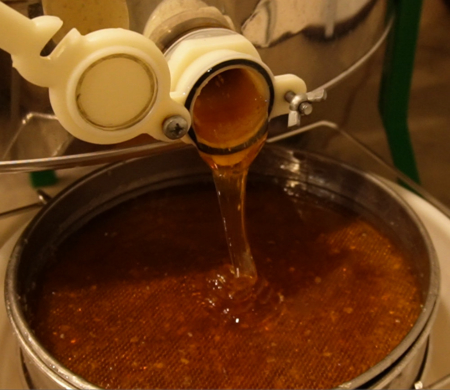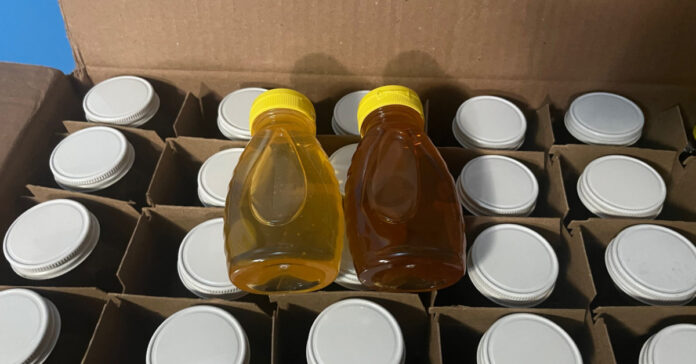My man cave is now home to cardboard boxes holding a variety of honey jars. We have 8-ounce squeeze bottles, 12-ounce bears, 1-pound glass jars and plastic squeeze bottles, and quart glass jars. The latter hold about 3 pounds each because honey is heavier than water.
We harvested and extracted 85 pounds of honey, plus a few pounds my daughter took home. That was less than I had expected, given the number of supers on the hive, but more on that later. Of this new batch, 24 pounds goes to one retailer, two smaller sellers will get a dozen each, and then three quarts are going to individual customers who have been eagerly awaiting the harvest. That accounts for 57 pounds, leaving me about a third of our harvest to sell to our egg customers and to replenish our retailers should they sell out before the August harvest. That’s when we expect to harvest the bulk of our honey.
We sell the smaller bottles at $1 per ounce, $15 for a pound, and $40 for a quart. When we sell to retailers, they get 20 percent off if they buy a dozen and can sell it at whatever the market will bear. Those in touristy areas tend to have higher prices.
Two Varieties
As you can see in the photos, we harvested two different honeys: a dark honey that is probably from Tulip Poplar nectar and a lighter honey that is consistent with what we get each spring. It’s most likely a mix of wildflower, blackberry and locust nectar. Both are tasty but quite different. The dark honey has a robust flavor with toffee tones, while the lighter version has a more traditional honey flavor with a bit of a zing that lingers on the tongue.
We harvested twice as much of the lighter color, so our customers will get more of it than the dark.
Thicker Honey

It was such a wet spring I was concerned about the percentage of water we would see in our honey. As a result, I harvested only frames of honey that were at least 80 percent capped. Many partial frames were left in the supers. In hindsight, that may not have been necessary. Our light honey was 15.5 percent water, and the dark was just over 16 percent. Most beekeepers agree that anything under 18 percent is good quality honey. I aim for 17.5 percent or less.
Can honey be too thick? Only if you expect to pour it out of the jar. This is why I like the plastic squeeze bottles. Pouring honey with a 15.5 percent moisture content makes me want to sing Carly Simon’s “Anticipation.” Unlike the classic Heinz Ketchup glass bottle, you can stick a spoon in our glass honey bottles and scoop out the honey. That’s even more important when the honey crystalizes, which it may do over the winter.
Crystalized Honey
Low temperatures speed crystallization, but most honey will eventually crystalize. I have one customer who enjoys crystalized honey and is always willing to buy it, but most people prefer their honey in its traditional liquid format. There’s nothing wrong with crystalized honey, but it doesn’t look as appetizing. If we have crystalized honey, we warm it until it re-liquefies.
If your honey crystalizes in storage, you can re-liquefy it yourself using a heating blanket or a warm-water bath. The key is to keep the honey under 110°F to avoid destroying its beneficial enzymes. Just don’t microwave your crystalized honey.
We have some honey from 2021 that never crystalized and we have honey from 2023 that looks as solid as a rock, so we can never predict what will happen with a particular batch. It depends on the ratio of glucose to fructose, and that depends on the nectar source. Blackberry honey is among those that are supposed to be slow to crystalize, so we will hope this harvest stays liquid for at least eight or ten months.
The hot water bath method will re-liquefy your honey, but it may also ruin your label. We learned that lesson the first year, and now we don’t label our jars until we are ready to sell them.
Honey for Prepping
Just a reminder: Honey has an unlimited shelf life, as long as it is in a sealed container. For long-term storage, I prefer glass because it is impermeable, while plastic may not be. Store honey in quart canning jars and then you can use the jars to preserve your garden produce after you eat the honey.
In a post-SHTF scenario, honey can replace sugar in baking and cooking, be used to sweeten jellies and juices, improve your oatmeal, sweeten your tea, and can replace maple syrup for pancakes. If you have no butter, honey will go great on your bread and biscuits. It can also be used to soothe sore throats, as a treatment for hay fever, and to help fight infection when applied to scrapes, abrasions and other minor open wounds. These benefits make it ideal for barter.
Honey has 1380 calories per pound. After your first lean winter following the collapse, you’ll probably need to put on some weight to help you live through the next winter. By the end of this honey season, we expect to harvest 300,000 to 400,000 calories worth of honey. I’m not suggesting you should live on honey, but two ounces of it a day will add 172 calories to your diet. Extra calories may be the last thing the average American needs today, but the time may come when every calorie will count.







